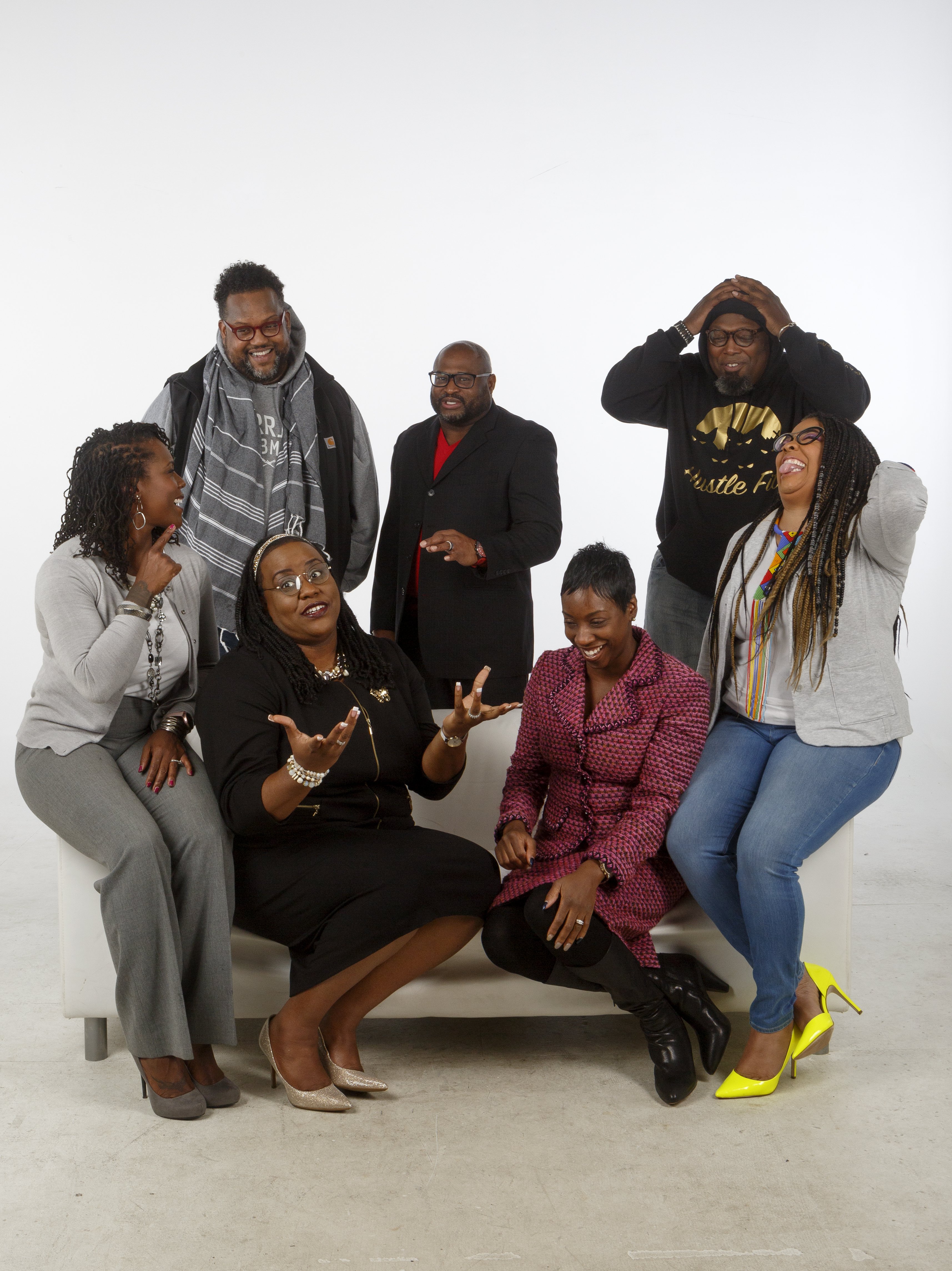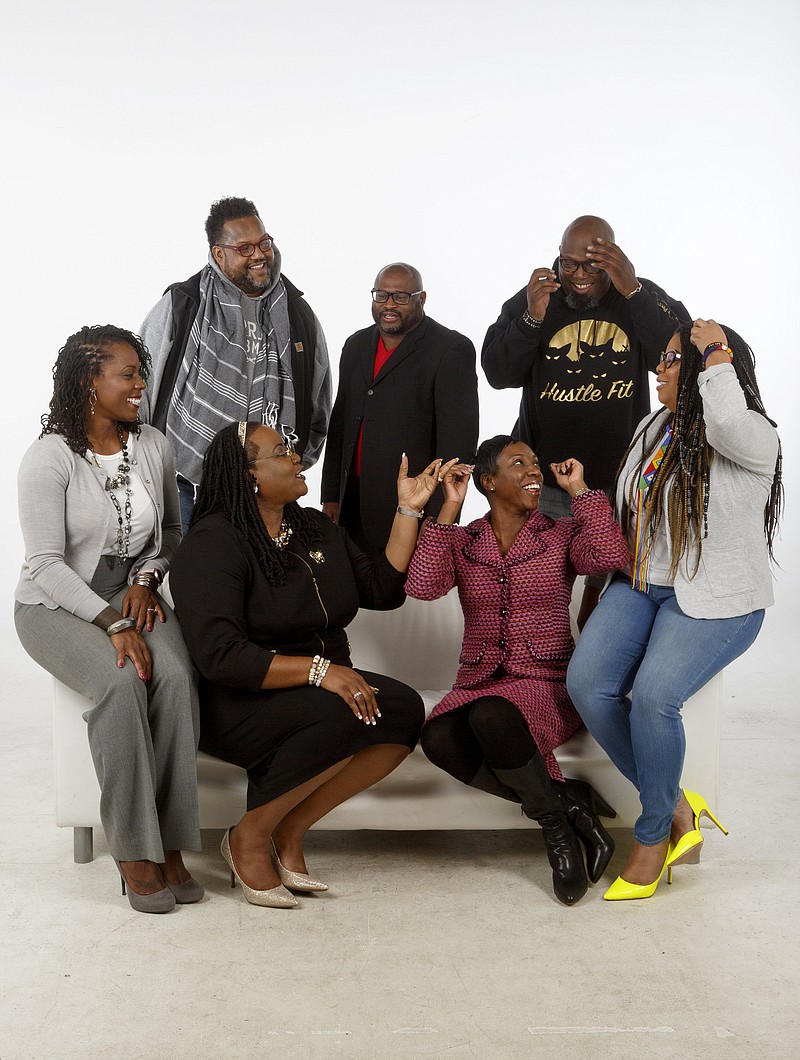 Staff photo by C.B. Schmelter / Members of Sankofa joke during a photo shoot in the studio at the Times Free Press on Monday, Dec. 2, 2019 in Chattanooga, Tenn. They are (sitting from left-to-right) Comelia Franceschi, Lakweshia Ewing, Karitsa Jones, Carmen Davis, (standing from left-to-right) James McKissic, William Jones and Shane Morrow. Not pictured are members Gabriel Franceschi, Wade Hinton, Shawanna Kendrick, Chantelle Respert, Chad Suttles and Rebecca Suttles.
Staff photo by C.B. Schmelter / Members of Sankofa joke during a photo shoot in the studio at the Times Free Press on Monday, Dec. 2, 2019 in Chattanooga, Tenn. They are (sitting from left-to-right) Comelia Franceschi, Lakweshia Ewing, Karitsa Jones, Carmen Davis, (standing from left-to-right) James McKissic, William Jones and Shane Morrow. Not pictured are members Gabriel Franceschi, Wade Hinton, Shawanna Kendrick, Chantelle Respert, Chad Suttles and Rebecca Suttles.What's in a name?
Sankofa is a West African phrase that means to go back and get something. It is symbolized by a bird with its feet firmly planted forward and its head turned backward, symbolizing progress informed by an understanding of the past.
The members of Sankofa, a local giving circle, pool their own money and decide collectively how to best direct those dollars to strengthen communities of color. But there's more than money at work when it comes to the power of this giving group, says Lakweshia Ewing, a member of the fund from its beginnings in 2015.
"We are not a gatekeeper to the black community, but we understand the importance of social capital and networking," Ewing says. "With the Howard (School) book club, for example, we gave the money, but we also leveraged a relationship we had with Barnes and Noble."
Connecting educators at Howard with contacts at the bookseller led to a fundraiser where Barnes & Noble donated a portion of sales from one day to the book club. That's one example of how members of Sankofa make their giving go as far as possible, Ewing says.
"Here's a connection, here's a door you can go through from now on," she says. "Leveraging social capital is paramount to survival. Who you know goes a long way."
Sankofa was born in 2015, when the group of about 20 realized they were constantly seeking each other out for support in their roles on boards and committees across the community. They decided to use their diverse professional backgrounds and broad social networks to turn their collective passion for philanthropy into action.
The members of Sankofa include influencers from across business, education and the arts, including Karitsa Jones, a member of the Hamilton County School Board; James McKissic, president of ArtsBuild; Shawanna Kendrick, a community organizer for the Hamilton County district attorney's office; Chantelle Respert, assistant vice president and senior regulatory counsel at Unum; and Shane Morrow, the founder and executive director of the RISE Collective, which stands for Responsive Initiatives for Social Empowerment.
"We started talking and realized, we've all got some money," says Ewing, an entrepreneur with a background in education. "What if we all put $100 into a pool every month and gave it to whoever we wanted?"
Sankofa is housed under the umbrella of the Community Foundation, but the funds come from members of the group, which ranges from 12 to 20 people. Decisions about donations are all made by the same small group, and one perk of that approach is that Sankofa members can focus on causes close to their hearts.
"People might say, 'What's the return on paying for a kid to attend a battle of the bands at an HBCU (historically black college or university)?" Ewing says. "It's the exposure. It's so important. We know what it means to be the first kid in a family to go to college. Many of us were that kid."
In their first four years, Sankofa gave $130,000 to causes ranging from band instruments and plumbing to clothing and toiletries. In their fifth year, the group's goal is to give $50,000 to causes they feel passionate about.
The Tennessee Association of Funding Professionals' Southeast Chapter named Sankofa the Corporate Philanthropists of the Year in 2019 - an honor the group was thrilled to receive, but one they aren't sure exactly fits, Ewing says.
"We're a fund. It's an African American giving circle," she says. "Some people have this view of philanthropy that it's a big corporation or a white man in a suit raining down money. It's not. It's giving from what you have."
Examples of giving
* Howard School book club - $800* The Springs, a home for HIV-positive women - $620.98* Dalewood Middle School girls basketball team - $990* CommUNITY Haven House - $2,600 for plumbing work* Citizens Safety Coalition - $800 for transportation to Alabama A&M college tour* Brainerd High School - $5,300 for band instrument purchase and repairs* Calvin Donaldson Environmental Science Academy - $500 for library’s maker space project in celebration of Black Philanthropy Month* Sister City Association of Chattanooga (SCA) - $500 for World Smart Project in Celebration of Black Philanthropy Month* Journey Educational Services, Inc. - $1,000
